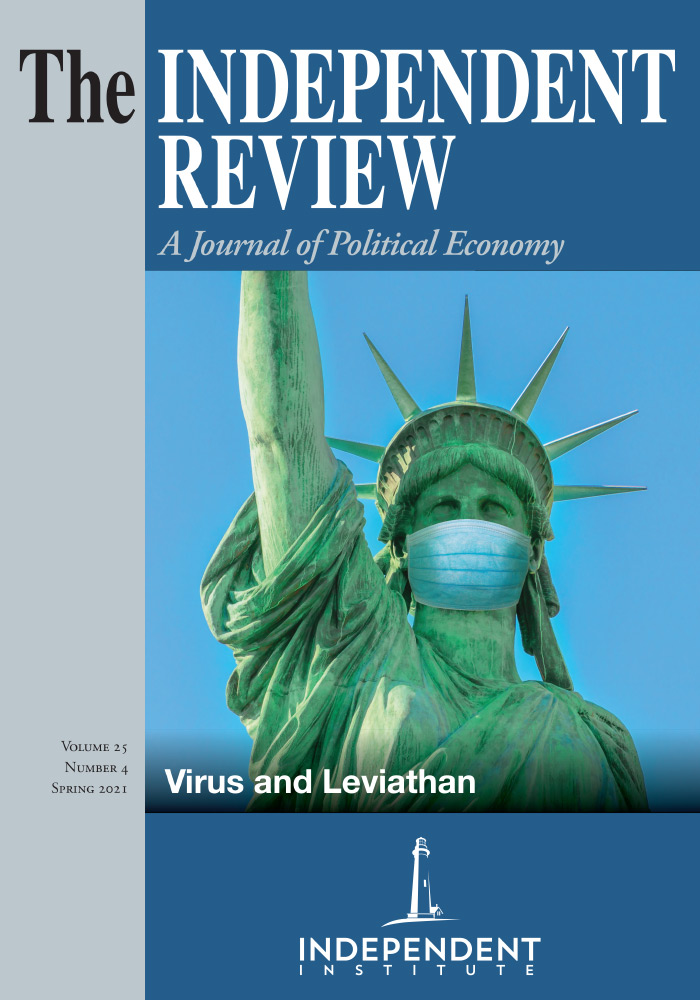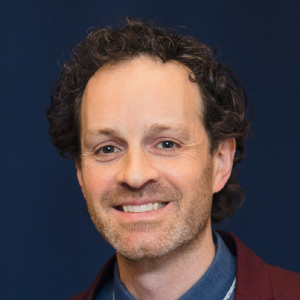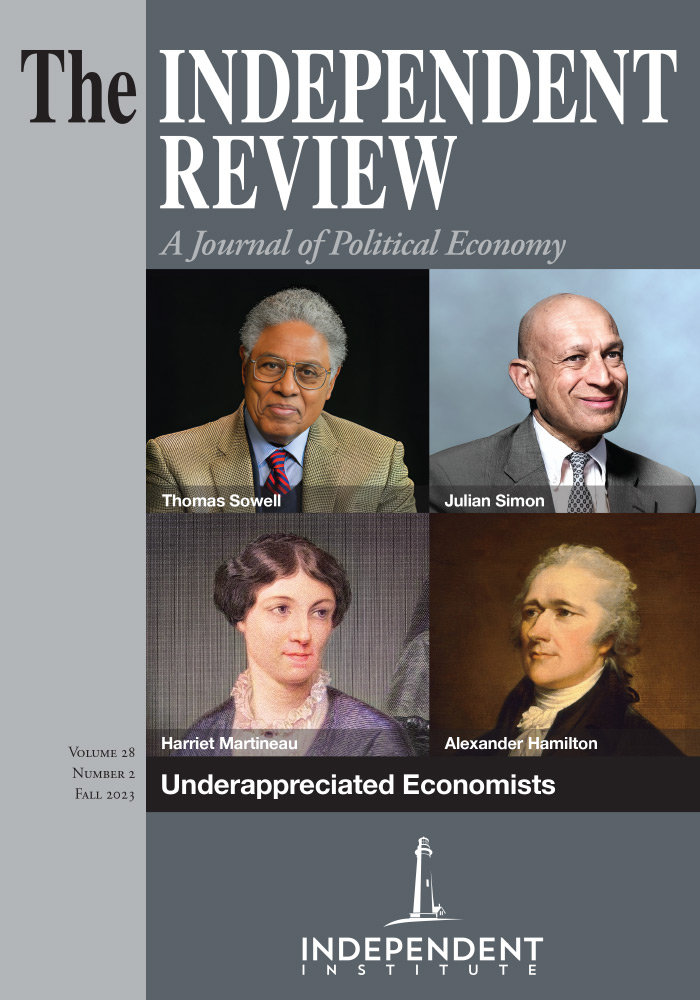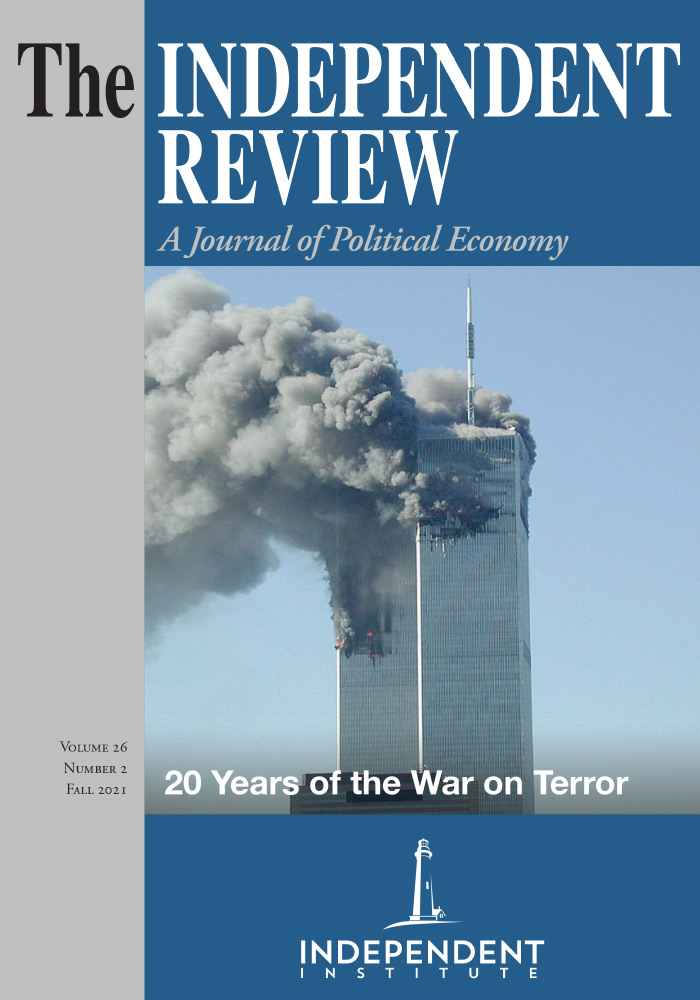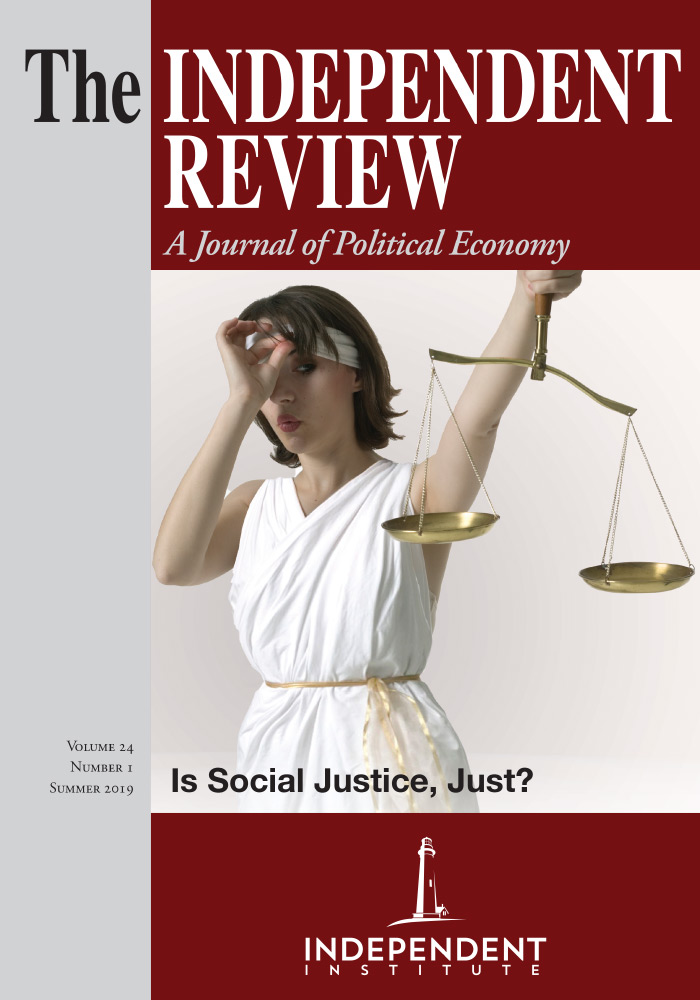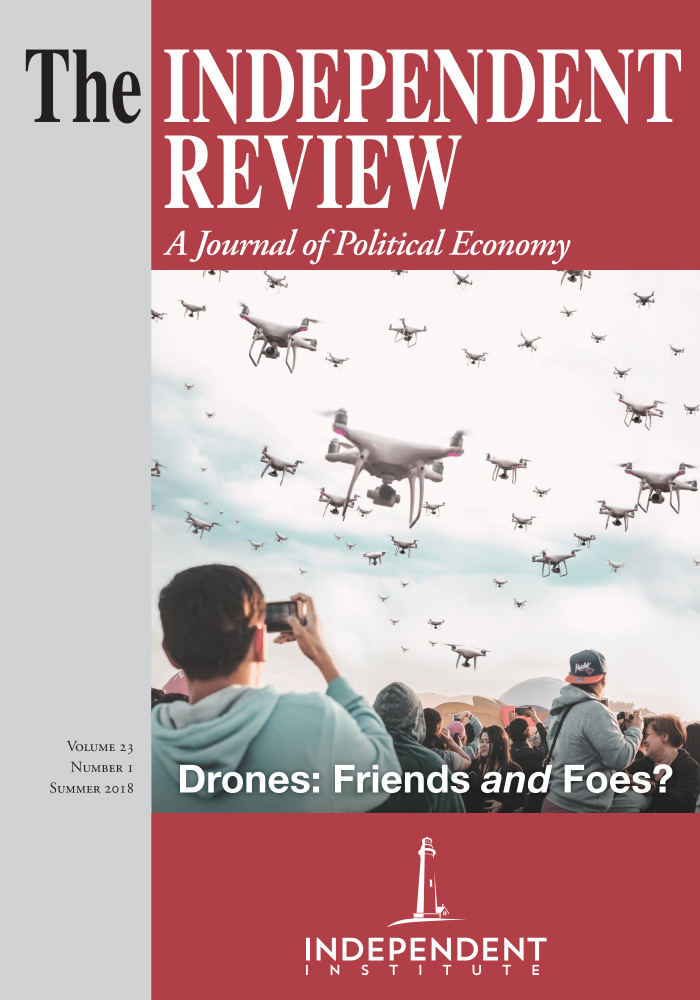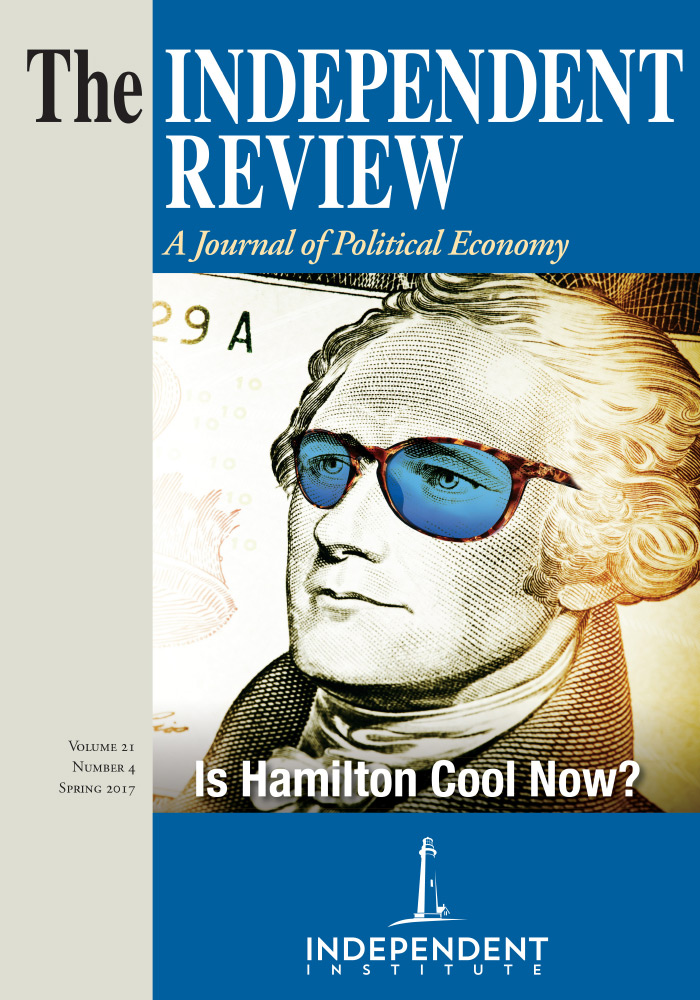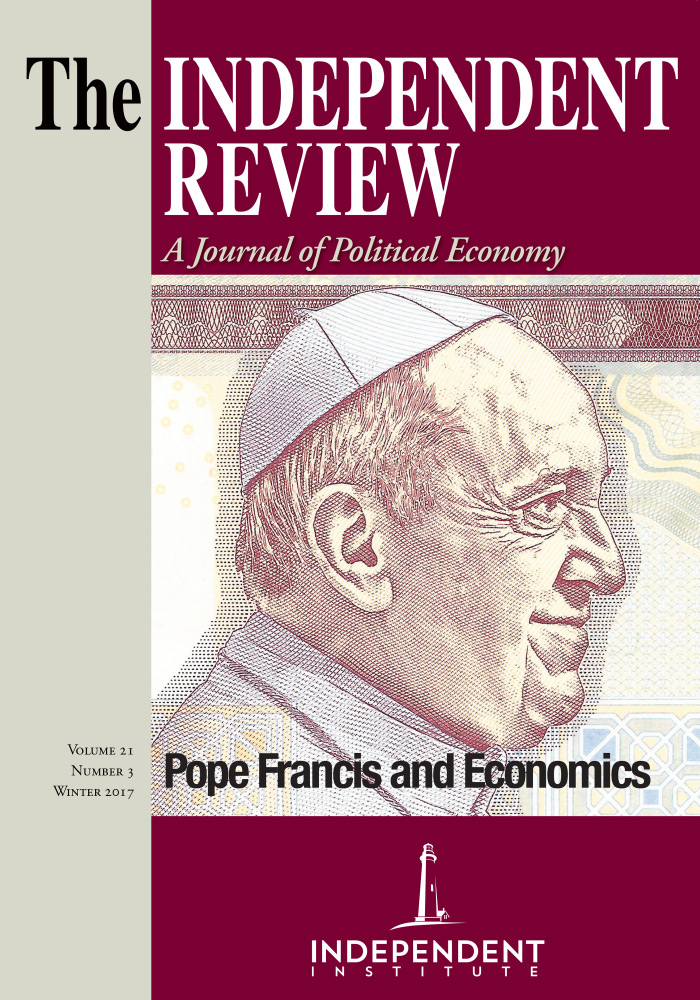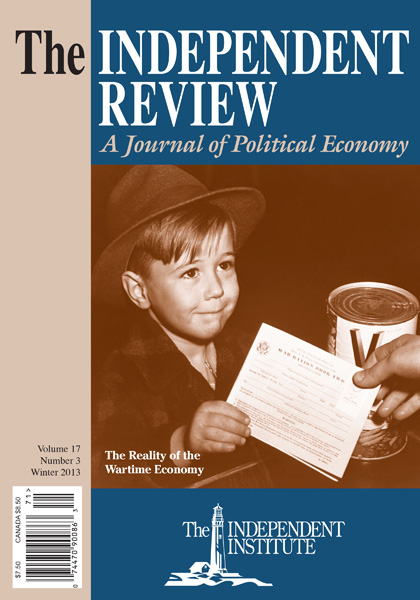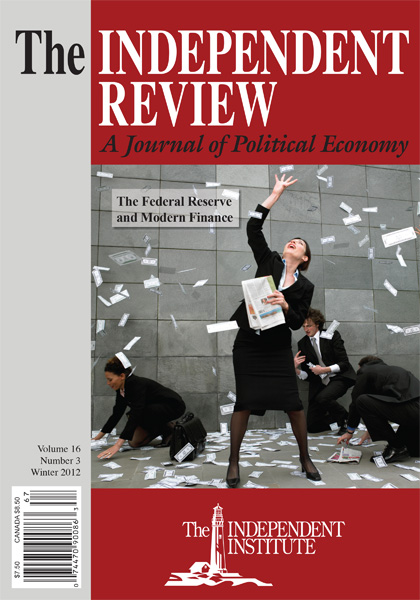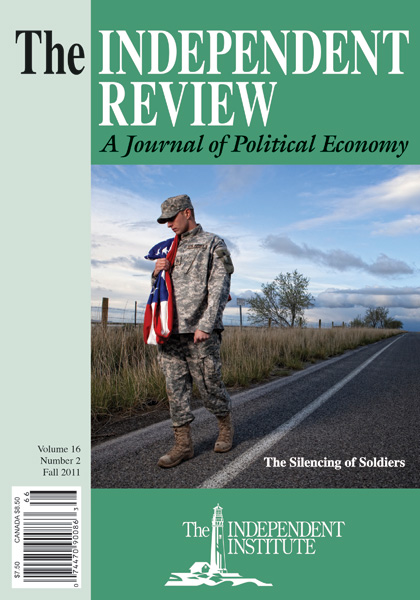In response to the COVID-19 pandemic, governments around the world adopted a variety of policies expanding the scope of their power. Some of these effects are immediate and observable. Others, however, are not readily observable and only appear over time. We explore these long-run consequences with specific focus on how institutional changes can persist after a public health crisis ends, causing increases in state power. These changes have the potential to undermine the liberties of future persons and disrupt bottom-up, non-state processes of social coordination. We illustrate these dynamics with three historical case studies—(1) The bubonic plague in Cape Town, South Africa in 1901 and its influence on apartheid, (2) The emergence of modern zoning and urban planning in the United States in response to the cholera, typhoid, smallpox, and tuberculosis epidemics, and (3) Compulsory vaccination in response to the smallpox epidemic of 1902.
Article
1. Introduction
In response to the COVID-19 pandemic, governments around the world adopted a variety of policies including, but not limited to, state imposed stay-at-home orders, the shuttering of non-essential business (as determined by government officials), and lockdowns of varying degrees. New state powers require new forms of enforcement and many governments have adopted police state powers to enforce these orders (Coyne and Yatsyshina 2020). These powers include direct and indirect surveillance, fines, excluding people from government services as punishment, and the use of physical force against violators (see, for instance, Amnesty International 2020, Habeeshian and McDade 2020; Kallingal 2020, Neil 2020, Pasley 2020, Speri 2020, Tuccille 2020). In some instances, such as in Poland and Russia, political officials have used the pandemic as justification to institutionalize expanded state powers by changing rules about elections, placing allies in key judicial position, and silencing critical media coverage (see Figlerowicz 2020, Nadeau 2020).
As the COVID-19 experience makes clear, policy responses to public health crises can have real effects on the scope of government power. Some of these effects are immediate and observable. Others, however, are not readily observable and only appear over time. The purpose of this paper is to explore these long-run consequences with specific focus on how institutional changes can persist after a public health crisis ends. Our central argument is that state expansion during a pandemic can alter the constraints faced by future political decision-makers, causing increases in state power. These changes can undermine the liberties of future persons and disrupt bottom-up, non-state processes of social coordination.
To develop our argument, we draw on both theory and history. Economic historian Robert Higgs (1987, 1995, 2004, 2005, 2007, 2012) has extensively studied crises and the growth of government. He argues that during a crisis government power increases in both scale (i.e., size) and scope (i.e., the range of activities undertaken). While some of these expansions are rolled back once the crisis subsides, some persist. New agencies, interest groups, legal precedents, and changes in ideology regarding the state-citizen relationship all contribute to a post-crisis growth path that involves larger government, both in scale and scope, as compared to what would have occurred absent the crisis. We extend this framework to the issue of pandemics and infectious disease outbreaks to understand how public health crises can lead to increases in state power.
Our analysis also contributes to two other literatures. The first is the literature on the tradeoff between individual freedom and public health as it relates to infectious disease (Troesken 2015). The logic underlying this tradeoff is that individuals and local governments are unable to sufficiently deal with infection externalities. The central government, in contrast, is better able to internalize these externalities through policies such as quarantines and compulsory vaccinations. These policies increase public health by reducing individual rights and freedoms. We contribute to this literature by clarifying the costs associated with the tradeoff between public health and liberty. Our analysis demonstrates that the costs to freedom, which are often long, variable, and unanticipated, will tend to be understated, sometimes severely.
The second is the literature in economic epidemiology on the optimal control of infectious diseases (see Weimer 1987; Gersovitz 1999; 2011; Goldman and Lightwood 2002; Francis 2004; Gersovitz and Hammer 2001, 2003, 2004, 2005; Barrett and Hoel 2005; Rowthorn, Laxminarayan, and Gilligan 2009). This literature typically models the state as a benevolent social planner with access to a social welfare function. Given these assumptions, the analyst is able to determine the optimal government responses to infectious disease. In this approach, concerns about the perverse consequences of permanent expansions in government power are a non-issue as a benevolent and omniscient public health planner adopts only those policies which maximize social welfare (see Coyne, Duncan, Hall 2020). We contribute to this literature by offering a more complete understanding of policymaking and how decisions by social health planners in responses to infectious disease can have long-lasting and potentially perverse consequences.
We proceed as follows. In the next section, we offer a theoretical framework for understanding how crises contribute to the growth of government. We also explore some short-run and long-run consequences associated with this type of crisis-induced government growth. Section 3 applies this framework to three historical cases of infectious disease outbreaks to illustrate the dynamics of government growth. These include—(1) The bubonic plague in Cape Town, South Africa in 1901 and its influence on apartheid, (2) The emergence of modern zoning and urban planning in the United States in response to the cholera, typhoid, smallpox, and tuberculosis epidemics, and (3) Compulsory vaccination in response to the smallpox epidemic of 1902. Section 4 concludes.
2. Crises and the Growth of Government
Crises, whether real or perceived, provoke members of the public to call for a response. During crises people fear for their lives and their livelihoods, and understandably they want people they view as having expertise to “do something” to address the crisis. The specific source of this response can vary and may include private collective responses, government initiatives, or some mix of the two. Higgs (1987, 2008) emphasizes that in the face of a crisis, ideology—beliefs about social relations and all involved in those relations—shapes the solutions people seek and support.
Higgs (1987) provides examples prior to the Progressive Era in which widespread beliefs about the limits of federal state power prevented the federal government from creating new programs in response to crises. The beliefs and norms of both officials and members of the public placed constraints on federal actions, which held even during perceived crises. In other words, prevailing ideologies placed limits on the governmental responses citizens and officials advocated during crises.
Conquest (2001: 30-1) makes a similar point about robust democracy, noting that a “democratic community enjoying political liberty is only possible when the attachment of the majority of the citizens to political liberty is stronger than the attachment to specific political doctrines.” As Conquest notes, liberty requires the virtue of apathy toward elaborate policies intended to achieve grand societal outcomes. Where such apathy exists, democracies tend to protect constitutionally enumerated rights because no group is empowered to “reconstruct the social and political order by sacrificing the minority” (2001: 30). As Conquest explains, however, crises draw the attention of the general populace to the political instrument, making them less apathetic and more prone to bouts of extremism that can result in marked change of the governing order, often taking the form—in the 20th century, at least—of a loss or erosion of individual rights, especially for political minorities.
Ideologies are not static. Prevailing beliefs change over time. During the Progressive Era many people became convinced that the federal government ought to manage a wide range of social and economic issues under the guise of “scientific management” (Taylor 1911). They believed that government must take pro-active steps to avoid crises and, when crises occurred, that federal officials must take bold steps to address the emergency. The theory of scientific management by experts using public officials as their proxy instruments culminated in the economically interventionist policies during the Great Depression and the influence of Franklin Delano Roosevelt’s “Brain Trust” in making those policies, many of which were fashioned on the apparent economic success stories of nouveau fascism in interwar Europe (White 2012: 99-125).
Comparably expansive views on the role of the federal government and the necessary influence of experts in governance, both domestic and international, persist today (see Easterly 2012, Levy and Peart 2016, Koppl 2018). The result is that public officials, incentivized by people’s beliefs regarding the appropriate and acceptable role of the state and its experts, are more willing to enact interventionist policies to address crises. This sets the stage for both short-term and long-term increases in the overall size of government.
Interventionist policies can cause two forms of government growth. They can increase the scale, or size,of government, essentially the amount of resources used for governmental activity. The scale of government is typically measured by government spending as a percentage of GDP or by examining how many bureaucrats a government agency hires. By contrast, the scope of government refers to the range of powers government officials possess. If a police force retains the same budget and labor force, but acquires new powers to surveil citizens, then the scope of their power has increased even though the scale of their budget remains the same. Scale and scope can be correlated but need not be. Government budgets may remain flat while the range of state activities undertaken with that budget may change and expand.
As government grows on the scale-scope margins multiple changes can occur. First, the ideology of members of society—citizens, elected officials, and non-elected bureaucrats—can change regarding the expectations of acceptable government activity. Before officials initiate a new policy during a crisis situation that intervention might seem radical or invasive. Afterwards, however, it becomes normalized. People, for instance, might view the intervention as necessary and see it as the only way to solve the problem the intervention seeks to address. This shift in ideology makes it less likely that the intervention will be fully rolled back. It also reinforces interventionist premises, which makes new interventions more likely during future crises.
Similarly, a new intervention can alter legal precedents regarding the scope of governmental activity. If an intervention is contested in court, a judge may uphold the constitutionality of that intervention. This creates precedent which will then shape future legal decisions about the scope of government. Since precedents often relate to abstract constitutional rules rather than just narrow policy issues, an intervention meant to address one crisis may have long-run consequences for seemingly unrelated policy issues.
Expansions in government also create vested interests that work to preserve or maintain the benefits associated with expanded state activities. For example, if a new bureaucracy, or a new group within an existing agency, is created to combat a specific health issue, its employees will have an incentive to maintain and increase the budget of the agency. They will seek to keep their jobs and obtain additional resources and discretionary power. This means that even if the new bureaucracy is intended to address a temporary public health crisis, its employees will engage in rent-seeking behavior to maintain and expand the bureaucracy even after the crisis subsides.
Together, these factors interact such that interventions introduced during a crisis will often not be fully rolled back when the crisis subsides. Some aspects of the intervention will recede. Stimulus spending may be discontinued after a recession as might conscription after a war ends. However, while the overall size of government will often decline after a crisis ends, it tends not to return to their pre-crisis growth path. Instead, for the reasons discussed above, the interventions pursued during a crisis create long-term institutional changes. These changes leave government permanently larger than it would have been absent the crisis (Higgs 1987).
Currently, experts in economics, political science and international relations are voicing concerns about how policy measures enacted during the COVID pandemic may lead to bigger governments and more surveillance (see Walt et. al., 2020). They expect an increase of location tracking and health checks during travel, permanent intervention into the workplace and the establishment of social network surveillance to manage future pandemics, further intervention into supply chain management in the form of tariffs and export bans (particularly in medical supplies), and subsidies to close overseas plants and open plants on national soil as is already being seen in Japan (Reynolds and Urabe 2020), large welfare states characterized by socialized medicine and wealth redistribution, a larger role for centralized technocratic rule, new more direct power by financial regulators and centralization of agency power, nationalistic localism of production and the disintegration of global trade, a permanent degradation of the democratic process by virtue of COVID-era executive orders, and the end of digital medical privacy. While it remains to remains to be seen if, and how, these changes manifest, what is clear is that institutional fabric of domestic and international life will change in response to government policies associated with COVID-19 pandemic.
In the following case studies, we show that government growth in the wake of infectious diseases is not just a possibility, but a historical reality. In the past, responses to infectious diseases contributed to institutionalizing racial apartheid, implementing residential segregation through zoning, and eroding civil rights and bodily autonomy through compulsory vaccination jurisprudence.
3. Historical Cases
3.1 The Sanitation Syndrome: The 1901 Cape Town Plague and Apartheid
“Sanitation syndrome” is an erroneous sociopolitical and scientific belief that conflates minority racial and ethnic characteristics and communities with disease risk, particularly infectious diseases that spread to the wider community (Swanson 1977). In Léopoldville, the capital of the Belgian colony now known as the Democratic Republic of the Congo, a cordon sanitaire of uninhabited ground had been enforced within the city to “prevent the spread of African disease into the white residential areas” (La Fontaine 1970: 19). Swanson (1977) describes a great many examples of the sanitation syndrome entangling racism with fear of epidemic throughout the 19th and 20th centuries, but the sanitation syndrome is perhaps best exemplified by the 1901 Cape Town plague, which laid the foundation for apartheid in South Africa.
The bubonic plague, likely imported in with Argentinian fodder for the troops’ horses, reached Cape Town in 1901, during the South African war. British officers were quick to place blame on the ‘slums’ populated mainly by “Kafirs,” the derogatory term used by the British to refer to black South Africans. Cape Town’s Medical Officer of Health Dr. John Gregory was already biased against the African residential areas, calling them “scattered nests of filth” (Swanson 1977: 392). As Swanson (1977: 393) notes, “...the plague itself did not create anxieties full-blown, but it focused them sensationally.” Not only were African residential areas the focus of sanitary measures regardless of the parity of infections between white and non-white South Africans, but Africans were soon the subject of the mass removal to a residential location outside the Cape Town urban and suburban limits, by virtue of the Public Health Act (itself inspired by an epidemic of smallpox in 1882-3). Between six and seven thousand Africans were removed forcibly from their homes to a sewage farm called Uitvlugt, to live in horrible conditions (Swanson 1977: 393).
Dr. Gregory and many other colonial officials soon after became proponents of maintaining the segregation. The main arguments for the legislation enacting compulsory race-based segregation mention, in some form or another, the theory that Africans spread or incubated infectious disease. Thus, the Higgsian hypothesis of ideology (racism) interacting with an event (the plague) given a particular institutional context (war-time colonialism) led distinctly to a socially destructive apartheid whose negative consequences are still felt by South African citizens today.
3.2 Infectious Disease as the Impetus for Zoning and Urban Planning
“In many respects, sanitary engineers were the first urban planners in America” note Perdue, Stone and Gostin (2003: 1390). Just as modern urban planners call for an increase in walkable neighborhoods in cities today to improve the healthfulness of inhabitants (Schilling and Linton 2005), with reference also to improving COVID pandemic outcomes (Loh, Love, and Vey 2020), experts of the Progressive Era were arguing against dense and walkable urban neighborhoods. The path from public nuisance jurisprudence laid down in English common law to modern unwalkable and segregationist zoning plows straight through the sanitation and hygiene concerns of densifying cities during the Industrial Revolution and Progressive era. Modern zoning would not have come to pass without the cholera, typhoid, smallpox, and tuberculosis epidemics which were used as Progressive-era justifications for zoning and urban planning, even though the science of ‘miasma’ behind Progressive urban planning has been long since disproved.
Modern city zoning and urban planning has its roots in the sanitary engineers of the Progressive Era, effectively moving residential areas out and away from businesses and leading to the modern ‘unwalkable’ American city. The ‘City Beautiful’ movement during the latter Industrial Revolution exemplifies the sanitation syndrome in city planning, as sanitation concerns rooted in epidemic spread were used to justify prevailing Progressive beliefs that immigrant and poor populations in high-density and cheaper housing were incubators and spreaders of infectious disease (Nolan 1916, Scott 1971). The science of the era largely stressed the since-disproved miasma theory that ‘bad air’ from particles of decomposing matter was to blame for epidemics, the belief echoed by architects and doctors alike (Fogelson 2001).
In New York City in particular, Jacob Riis’s sensational How the Other Half Lives, originally published in 1890, blamed the lack of light and fresh air in the cheap and dense housing occupied by immigrants in the late nineteenth century for epidemics of cholera, smallpox and tuberculosis, and noted that the “dread of advancing cholera” correlated with dark and stagnant tenements was the primary justification for the Tenement House Act of 1867 (Riis 2011 [1890]: 69). While there is a correlation between relative lack of light and air and infectious diseases spreading through dense tenements, the association is not plausibly causative, as advancements in infectious diseases later showed. The much more likely cause of infectious disease spread in dense housing of the era was the tendency to place outhouses next to water cisterns in the tiny tenement backyards. Further legal measures based in sanitation theory culminated in New York City’s Tenement House Act of 1901, focused largely on de-densification through setbacks, the requirement that all rooms have windows, the increase of lot size and significant decrease of building-to-lot ratio, and the requirement that each apartment have its own toilet facilities. ‘Old-law’ tenements refitted to comply with the new law saw monthly rents rise from about $9.50 - $13 ($291.50 - $400 in 2020 dollars) prior to the 1901 act to $10 - $15 ($304 - $460 in 2020 dollars) after the act was passed (Hopkinson 2003: 29).
Zoning was a logical step in the progression of Progressive de-densification justified by infectious disease spread, with the primary effects of making private market urban housing less affordable to the poor and segregating residential areas based on race and ethnicity. The 1926 U.S. Supreme Court case Ambler Realty Co. v. Village of Euclid is the benchmark zoning case that allowed the zoning of private property on the bases of health and public welfare grounds, despite a lower court observing that the practical aims of Euclid zoning were clearly to enforce racial segregation (Rothstein 2017: 52-53). These beliefs persisted through the Great Society era—the creation of San Francisco housing projects in the 1960s was partially justified as improving urban sanitation (Shah 2001).
While the racial and epidemiological beliefs that motivated early zoning statutes eventually ended, zoning laws did not. Instead, zoning laws have become even more restrictive. From 1950 to 1970, housing prices and construction costs grew at around the same rate. However, after 1970 housing prices skyrocketed, especially in large coastal cities, while construction costs declined. This divergence is largely a result of regulatory barriers to housing construction. One reason for this increasing restrictiveness is that homeowners have become more effective at influencing government, which is consistent with an interest group explanation (Lindsey and Teles 2017; Glaeser, Gyourko, and Saks 2005). While restrictive zoning laws have benefited homeowners by increasing the market values of their homes, the laws have significant costs. In particular, they reduce access to affordable housing (Glaeser and Gyourko 2003). This has further adverse consequences. People are often more productive when they congregate together in cities, but zoning laws make moving to highly productive cities unaffordable for many. This may adversely affect economic growth while restricting mobility which contributes to substantial income inequality between regions (Lindsey and Teles 2017). While zoning regulations may have emerged even absent infection disease, many of the laws that exist today find their origins in responses to public health crises and shaped by the dominant ideologies at the time. Consistent with our theoretical framework, these laws have outlived their initial justifications, due to the influence of interest groups, such as homeowners, and the normalization of zoning laws as a part of life.
3.3 Compulsory Vaccination and the Power of Precedent
In 1902, in the midst of a smallpox epidemic, the Board of Health in Cambridge, Massachusetts ordered “all inhabitants who had not been vaccinated within the past five years to submit to the procedure at once or incur a $5 fine, provided for by the Massachusetts compulsory vaccination law” (Willrich 2011: 285). At the time “the average weekly wage of an American factory worker was about $13,” so that $5 fine was significant (Willrich 2011: 285).
Pastor Henning Jacobson, a forty-five-year-old Swedish immigrant who lived in Cambridge, “had not been vaccinated since childhood” (Willrich 2011: 285). Dr. E. Edwin Spencer, the chairman of the Board of Health, offered to vaccinate Pastor Jacobson without charging him for the vaccination. Jacobson refused this offer. As a result, Jacobson “was later summoned to court, tried, and found guilty of ‘the crime of refusing vaccination’” (Willrich 2011: 286). He then refused to pay the fine, instead choosing to appeal the ruling.
Jacobson was concerned about adverse side effects from the vaccination. As a child in Sweden, he had been vaccinated, and experienced “great and extreme suffering” that he attributed to the vaccine (quoted in Willrich 2011: 287). One of his children also “suffered adverse effects from a childhood vaccination, convincing the minister that some hereditary condition in his family made vaccine a particular hazard for them” (Willrich 2011: 288).
Jacobson was tried, alongside several other vaccine resisters, in the Third District Court of Eastern Middlesex County. He spoke in his own defense in the courtroom. Along with his co-defendants, Jacobson was found guilty and ordered to pay the $5 fine. Jacobson appealed the ruling. He was represented by James Winthrop Pickering of the Massachusetts Anti-Compulsory Vaccination Society. By the winter of 1903, the smallpox epidemic in Cambridge had concluded, but the appellate legal battles had not. Pickering, along with his co-counsel Henry Ballard, prepared briefs to oppose compulsory vaccination before the Massachusetts Supreme Judicial Court. While the epidemic was over, the case concerned broader constitutional questions. Assistant District Attorney Hugh Bancroft, who represented the Commonwealth of Massachusetts, argued that “The legislature has an extensive undefined power, usually called the police power, to pass laws for the common good” (quoted in Willrich 2011: 299). The ideology of progressivism, which was growing in strength, supported an expansive view of the police power grounded in clear legal precedents.
The Supreme Judicial Court ruled unanimously in favor of the Commonwealth of Massachusetts. In the decision, Chief Justice Marcus P. Knowlton wrote that “The rights of the individual must yield, if necessary, when the welfare of the whole community is at stake” (quoted in Willrich 2011: 320). After his loss, “Jacobson appeared for sentencing in the Middlesex County Superior Court” (Willrich 2011: 322). He was fined $5, after which his new attorney, George Fred Williams, “filed a petition for a writ of error to the U.S. Supreme Court” (Willrich 2011: 322). The Supreme Court took the case. They had no other option, as “Congress did not give the Court power to pick and choose its own constitutional cases until 1925” (Willrich 2011: 322).
Before the Supreme Court, Williams presented arguments based on the Fourteenth Amendment. He argued that “by entrusting local boards with arbitrary powers to inoculate a healthy individual with disease—without making any exception for adults with special health conditions—the Massachusetts legislature had deprived Jacobson of his liberty without due process of law” (Willrich 2011: 324). Moreover, he argued that the law violated the equal protection clause, because it only offered health exceptions for children.
In a 7 to 2 opinion, the Supreme Court ruled in Jacobson v. Massachusetts (1905) that compulsory vaccination did not violate the Fourteenth Amendment. As Associate Justice John Marshall Harlan wrote in the majority opinion, “Upon the principle of self-defense, of paramount necessity, a community has a right to protect itself against an epidemic of disease which threatens the safety of its members” (quoted in Willrich 2011: 328). Harlan rejected the Fourteenth Amendment arguments against compulsory vaccination and compared epidemics to times of war. While Harlan argued that officials had the power to mandate vaccination, he treated this power as contingent on the crisis. Harlan also established that if a compulsory vaccination would harm the health or life of an individual, then judges could “interfere and protect the health and life of the individual concerned” (quoted in Willrich 2011: 329). However, despite this openness to medical exemptions, Harlan argued that Jacobson did not qualify for such an exemption, as he was “in perfect health and a fit subject for vaccination” (quoted in Willrich 2011: 329).
On its face, the decision appeared to simply authorize compulsory vaccination, and even to place some limits on that power. Had the decision only narrowly impacted compulsory vaccination perhaps few people would take issue given the positive externality aspects of vaccination against disease.[1] However, Jacobson v. Massachusetts set a precedent that impacted the scope of state power far removed from questions of vaccination against infectious disease.
Throughout the Progressive Era, government officials and experts alike promoted eugenics, and advocated extreme civil liberties abuses such as compulsory sterilization to achieve eugenic objectives (see Leonard 2016, Koppl 2018). Jacobson v. Massachusetts was used as precedent to uphold compulsory sterilization. In 1927, Justice Oliver Wendell Holmes wrote the majority opinion in Buck v. Bell, ruling that officials from the state of Virginia could forcibly sterilize Carrie Buck on the grounds that she was “feeble-minded.” Holmes wrote in his majority opinion, “The principle that sustains compulsory vaccination is broad enough to cover cutting the Fallopian tubes” (quoted in Willrich 2011: 334). He cited Jacobson v. Massachusetts to support his ruling. Indeed, Jacobson v. Massachusetts was the only case law that he cited (Willrich 2011: 334). Over two decades after the smallpox epidemic ended, a legal response to that crisis justifying expanded state powers was used as precedent to uphold eugenic sterilization. This illustrates how expansions in the scope of government to address one crisis situation can lead to unanticipated and unknowable expansions in state power in the future.
Jacobson v. Massachusetts has been cited in numerous other Supreme Court cases to justify expansive government powers. In addition to its use upholding forced sterilization, the casehas been used “to support the claim that warrantless entry by law enforcement officials may be legal when there is a compelling need and little time, and, in a recent dissent, to defend the federal government’s right during the twenty-first century war against terror to detain a U.S. citizen as an ‘enemy combatant’ without due process” (Willrich 2011: 335). When a policy expands the scope of government to address an immediate emergency, it creates institutional precedent that can have wide reaching consequences for civil liberties, especially when the policy is evaluated and upheld by the Supreme Court.
4. Conclusion
The costs of government responses to health crises will be understated because the long-term effects are long and variable and only become evident in the future. Expansions in government power are reversible but are often sticky due to changes in people’s ideology regarding the appropriate role of the state in relation to the citizenry, and to political economy factors such as vested interests and legal precedents regarding acceptable behaviors by the state (Higgs 1987). Moreover, expansions in state power associated with responses to infectious disease can expand into other areas of life and persist for decades after the public health crisis ends.
These realities offer reason for prudence and caution during public health crises, where there are often calls for government to act quickly and decisively. Both infectious disease and the various institutions that constitute human society are complex systems. Given limited human reason, interventions will be necessarily simple relative to the complexity of the systems being intervened upon. This will result in a range of unknowable, and possibly negative, “system effects” (Jervis 1977) which can have immediate and long-term effects.
This matters for the way social scientists approach issues of economic epidemiology. The orthodox model of optimal disease control assumes the existence of a benevolent social planner with access to a given social welfare function. From this perspective health planners adopt only those policies which maximize social welfare (Coyne, Hall, and Duncan (2020). But as our analysis makes clear, there is no way for health planners in the present period to know or anticipate the full consequences of their policies. Policies can have a range of short-term and long-term effects which harm human welfare.
Infectious disease poses a unique threat to a free society. On the one hand infectious diseases are characterized by “infection externalities” whereby individuals do not internalize the full costs of their behaviors. Many believe that the state is necessary to internalize these externalities. Empowering the government to do this, however, creates space for expansions in state power which can generate undesirable outcomes. The maintenance of free society requires simultaneously appreciating that collective action solutions are necessary in dealing with infectious diseases and that concentrating political power to provide these solutions creates a threat to individual liberty and freedom.
To begin to resolve the tension between these two realities one might start with the work of Elinor Ostrom (1990) who demonstrated that private people are often able to resolve collective action problems despite the predictions of theory to the contrary. Moreover, recent research in public administration emphasizes the importance of polycentric systems for addressing the diverse and heterogenous nature of collective action problems (Boettke 2018; Aligica, Boettke, Tarko 2019). This certainly applies to infectious disease where the nature of the infection externality, and related collective action challenges, vary not only across societies but within societies (see Coyne, Duncan and Hall 2020). Given the potential costs of choosing top-down government solutions to infections disease, these alternative institutional arrangements, which emphasize bottom-up diverse solutions, may be preferable for dealing with public health issues and maintaining a free society.
Note
[1] For instance, Brennan (2018: 37) discusses a range of arguments for compulsory vaccination, including arguments built on duties to serve the common good, consequentialist arguments based on cost-benefit analysis, and a libertarian argument that “antivaxxers are wrongfully imposing undue harm upon others.”
References
Aligica, Paul Dragos, Peter J. Boettke, and Vlad Tarko. 2019. Public Governance and the Classical-liberal Perspective. New York, NY: Oxford University Press.
Amnesty International. 2020. Philippines: President Duterte gives "shoot to kill" order amid pandemic response. April 2. Accessed April 16, 2020.
Barrett, Scott and Michael Hoel. 2005. “Optimal Disease Eradication,” Environment and Development Economics 12(5): 627-652.
Boettke, Peter. 2018. “Economics and Public Administration,” Southern Economic Journal 84(4): 938-959.
Brennan, Jason. 2018. “A Libertarian Case for Mandatory Vaccination,” Journal of Medical Ethics. 44(1): 37-43.
Conquest, Robert. 2001. Reflections on a Ravaged Century. New York, NY: W.W. Norton & Company.
Coyne, Christopher J., Thomas R. Duncan, and Abigail R. Hall. 2020. “The Political Economy of State Responses to Infectious Disease,” Mimeo.
Coyne, Christopher J. and Yuliya Yatsyshina. 2020. “Pandemic Police States,” Peace Economics, Peace Science and Public Policy, forthcoming.
Easterly, William. 2014. The Tyranny of Experts: Economists, Dictators, and the Forgotten Rights of the Poor. New York, NY: Basic Books.
Figlerowicz, Marta. 2020. “Democracy on Pause in Pandemic Poland,” Foreign Affairs. May 13. Accessed July 30, 2020.
Fogelson, Robert M. 2001. Downtown: Its Rise and Fall, 1880-1950. New Haven, CT: Yale University Press.
Francis, Peter J. 2004. “Optimal tax/subsidy Combinations for the Flu Season,” Journal of Economic Dynamics and Control 28(10): 2037-2054.
Gersovitz, Mark. 1999. Human Behaviour and the Transmission of Infectious Disease: An Economist’s Perspective. Adelaide, Australia: University of Adelaide.
_____. 2011. “The Economics of Infection Control,” Annual Review of Resource Economics 3: 277–96.
____. 2014. “Infectious Disease Externalities,” In Encyclopedia of Health Economics, Anthony J. Culyer (Ed). New York, NY: Elsevier Science B.V., pp. 35-39.
Gersovitz, Mark and Jeffrey S. Hammer. 2003. “Infectious Diseases, Public Policy, and the Marriage of Economics and Epidemiology,” World Bank Research Observer 18(2): 129–57.
_____. 2004. “The Economical Control of Infectious Diseases,” Economic Journal 114(492): 1–27.
_____. 2005. “Tax/subsidy Policies Toward Vector-borne Infectious Diseases.” Journal of Public Economics 89(4) :647–74.
Glaeser, Edward L. and Joseph Gyourko. 2003. “The Impact of Building Restrictions on Housing Affordability.” Economic Policy Review, 9 (2): 21-39.
Glaeser, Edward, L., Joseph Gyourko, and Raven E. Saks. 2005. "Why Have Housing Prices Gone Up?" American Economic Review, 95 (2): 329-333.
Goldman, Steven Marc and James Lightwood. 2002. “Cost Optimization in the SIS Model of Infectious Disease with Treatment,” The B.E. Journal of Economic Analysis & Policy 2(1): 1-24.
Habeeshian, Sareen and Mary Beth McDade. 2020. Mayor Garcetti announces water and power will be shut off for nonessential L.A. businesses that don’t close. KTLA. March 24. Accessed April 30, 2020.
Higgs, Robert. 2012 [1987]. Crisis and Leviathan: Critical Episodes in the Growth of American Government. Oakland, CA: Independent Institute.
____. 1995. “Introduction” in Hazardous to Our Health? FDA Regulation of Healthcare Products, ed. Robert Higgs. Oakland, CA: Independent Institute, pp. 1-14.
____. 2004. Against Leviathan: Government Power and a Free Society. Oakland, CA.: Independent Institute.
____. 2005. “Fear: The Foundation of Every Government's Power,” The Independent Review 10(3): 447-66.
____. 2007. Neither Liberty nor Safety: Fear, Ideology, and the Growth of Government. Oakland, CA.: Independent Institute.
_____. 2008. “The Complex Course of Ideological Change,” The American Journal of Economics and Sociology 67(4): 547-565.
____. 2012. Delusions of Power: New Explorations of State, War, and Economy. Oakland, CA.: Independent Institute.
Hopkinson, Deborah. 2003. Shutting Out the Sky: Life in the Tenements of New York, 1880-1924. New York, NY: Orchard Books.
Jervis, Robert. 1997. System Effects: Complexity in Political and Social Life. Princeton, NJ: Princeton University Press.
Kallingal, Mallika. 2020. Ankle monitors ordered for Louisville, Kentucky residents exposed to Covid-19 who refuse to stay home. CNN. April 3. Accessed April 29, 2020.
Koppl, Roger. 2018. Expert Failure. New York, NY: Cambridge University Press.
La Fontaine, J. S. 1970. City Politics. A Study of Leopoldville, I962-63. New York, NY: Cambridge University Press.
Leonard, Thomas C. 2016. Illiberal Reformers: Race, Eugenics, and American Economics. Princeton, NJ: Princeton University Press.
Levy, David M. and Sandra J. Peart. 2016. Escape from Democracy: The Role of Experts and the Public in Economic Policy. New York, NY: Cambridge University Press.
Lindsey, Brink and Steven M. Teles. The Captured Economy: How the Powerful Enrich Themselves, Slow Down Growth, and Increase Inequality. New York, NY: Oxford University Press.
Loh, Tracy H., Hanna Love, and Jennifer S. Vey. 2020. “The qualities that imperil urban places during COVID-19 are also the keys to recovery.” The Brookings Institute. March 25. Accessed on July 25, 2020.
Nadeau, John. 2020. “Putin is Using the Pandemic to Consolidate Power.” ForeignPolicy.com. May 18. Accessed July 30, 2020.
Neil, Denise. 2020. You’re not a snitch if you report those defying stay-at-home order, local officials say. The Wichita Eagle. April 5. https://www.kansas.com/news/coronavirus/article241743631.html Accessed April 30, 2020.
Nolan John (Ed.). 1916. City Planning. New York, NY: D. Appleton & Company.
Ostrom, Elinor. 1990. Governing the Commons: The Evolution of Institutions for Collective Action. New York, NY: Cambridge University Press.
Pasley, James. 2020. Philippine police reportedly shot a man dead under Duterte's orders to kill any lockdown troublemakers. Insider. April 6. Accessed April 30, 2020.
Perdue, Wendy C., Lesley A. Stone and Lawrence O. Gostin. 2003. The built environment and its relationship to the public's health: the legal framework. American journal of public health, 93(9), 1390–1394.
Reynolds, Isabel and Emi Urabe. 2020. “Japan to Fund Firms to Shift Production Out of China.” Bloomberg. April 8. Accessed July 23, 2020.
Riis, Jacob A. 2011 [1890]. How the Other Half Lives. David Leviatin (Ed.), New York NY: Bedford/St. Martin’s.
Rothstein, Richard. 2017. The Color of Law: A Forgotten History of How Our Government Segregated America. New York, NY: Liveright Publishing Corporation.
Rowthorn, Robert E., Ramanan Laxminarayan and Christopher A. Gilligan. 2009. “Optimal Control of Epidemics in Metapopulations,” Journal of Royal Society Interface 6(41): 1135-1144.
Schilling, Joseph and Leslie S. Linton. 2005. “The Public Health Roots of Zoning: In Search of Active Living’s Legal Genealogy." American Journal of Preventive Medicine 28(2): 96-104.
Scott, Mel. 1971. American City Planning since 1890. Berkeley, CS: University of California Press, Ltd.
Shah, Nayan. 2001. Contagious Divides: Epidemics and Race in San Francisco’s Chinatown. Berkeley, CA: University of California Press, Ltd.
Speri, Alice. 2020. NYPD’s Aggressive Policing Risks Spreading the Coronavirus. The Intercept. April 3. Accessed April 30, 2020.
Swanson, Maynard W. 1977. “The Sanitation Syndrome: Bubonic Plague and Urban Native Policy in the Cape Colony, 1900-1909.” Journal of African History 18(3): 387-410.
Taylor, Fredrich Winslow. 1911. Scientific Management. New York, NY: Harper & Bros. Publishers.
Troesken, Werner. 2015. The Pox of Liberty: How the Constitution Left Americans Rich, Free, and Prone to Infection. Chicago, IL: The University of Chicago Press.
Tuccille, J.D. 2020. The Surveillance State Thrives During the Pandemic. Reason. April 10. Accessed April 16, 2020.
Walt, Stephen W. and Alexandra Wrage, James Crabtree, Shannon K. O’Neil, Robert D. Kaplan, Kenneth Roth, Robert Muggah, Adam Posen, Kumi Naidoo and Bruce Schneier. 2020. “How the Coronavirus Pandemic Will Permanently Expand Government Powers.” Foreign Policy. May 16. Accessed July 24, 2020.
Weimer, Calla. 1987. “Optimal disease control through combined use of preventive and curative measures,” Journal of Development Economics 25(2): 301-319.
White, Lawrence H. 2012. The Clash of Economic Ideas: The Great Policy Debates and Experiments of the Last Hundred Years. New York, NY: Cambridge University Press.
Willrich, Michael. 2011. Pox: An American History. New York, NY: Penguin.
| Other Independent Review articles by Nathan P. Goodman | ||
| Summer 2023 | The Market Process as Nonviolent Action | |
| Fall 2020 | Polycentric Defense | |
| Fall 2020 | The Politics of War Powers: The Theory and History of Presidential Unilateralism | |
| [View All (4)] | ||
| Other Independent Review articles by Christopher J. Coyne | ||
| Spring 2024 | Murray Rothbard on War and Foreign Policy | |
| Fall 2023 | Kenneth Boulding: Knowledge, Conflict, and Power | |
| Summer 2023 | A Symposium on Gene Sharp’s The Politics of Nonviolent Action | |
| [View All (46)] | ||
| Other Independent Review articles by Abigail Devereaux | |
| Winter 2020/21 | Cryptodemocracy: How Blockchain Can Radically Expand Democratic Choice |

